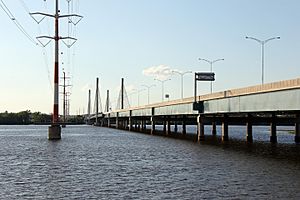Olivier-Charbonneau Bridge facts for kids
Quick facts for kids Olivier Charbonneau Bridge |
|
|---|---|

The A25 Bridge connecting Montreal and Laval, Quebec.
|
|
| Coordinates | 45°38′16″N 73°37′14″W / 45.63778°N 73.62056°W |
| Carries | Six lanes of |
| Crosses | Rivière des Prairies |
| Locale | between Laval (Duvernay district) and Montreal (Rivière-des-Prairies–Pointe-aux-Trembles) |
| Official name | Pont Olivier-Charbonneau |
| Characteristics | |
| Design | Cabled-Stayed Bridge |
| History | |
| Opened | May 21, 2011 |
| Statistics | |
| Daily traffic | 36,400 (2013) |
| Toll | $2.24-$3.20 with transponder, add $5.34 with picture |
The Olivier Charbonneau Bridge is a special bridge in Quebec. It connects Laval and Montreal by crossing the Rivière des Prairies river. This bridge is a toll bridge, which means you pay a small fee to cross it. It is one of only two toll bridges in Quebec.
Contents
Why the Bridge is Called Olivier Charbonneau
Before 2012, this bridge was simply known as the A25 Bridge. It was later given a new name to honor Olivier Charbonneau. He was a French explorer who lived a long time ago (from 1613 to 1687). Olivier Charbonneau was the very first person to live on Île Jésus. This island is now home to the city of Laval.
Building the Bridge
The Olivier Charbonneau Bridge is part of a bigger project. This project finished a 7.2 km (4.5 mi)-long section of Highway 25. The bridge helps cars, trucks, and buses avoid other busy roads. It also offers a way to get around the city of Montreal. Drivers can use it to connect to Highway 440. This helps them avoid the often-crowded Metropolitan Expressway.
This bridge is the second modern toll bridge built in Quebec. It is also the first toll bridge in the Montreal area since 1990. Construction started in early 2008. The bridge opened to traffic on May 21, 2011. It was finished on time and within its $500 million budget.
What Makes the Bridge Special
The Olivier Charbonneau Bridge is a type of bridge called a cable-stayed bridge. This means it uses strong cables to hold up the main part of the bridge. It has six lanes for traffic, with three lanes going in each direction. A barrier separates these lanes. There is also a special path on the east side of the bridge for people who like to cycle.
Soon after the bridge opened in 2011, over 25,000 vehicles crossed it every day. Just one year later, in May 2012, more than 35,000 vehicles were using the bridge daily. This adds up to about 12.8 million crossings each year!
How the Toll System Works
A company called Concession A25, S.E.C. owns the bridge. This company is a partnership between a large financial group and construction companies. This type of partnership is a way for private companies to help fund big public projects.
The bridge uses a modern electronic toll system. This system lets cars cross without stopping at a toll booth. You can get a special electronic sticker, called a transponder, for your car's windshield. If you cross without a transponder, the system takes a picture of your license plate. Then, an invoice is sent to you by mail. It is important to pay the toll and any fees on time.
The cost to cross the bridge can change. It depends on the size of your vehicle. It also depends on the time of day you cross. Good news for some: pedestrians and cyclists can cross for free. Also, since 2016, electric vehicles can cross for free too!
Gallery










